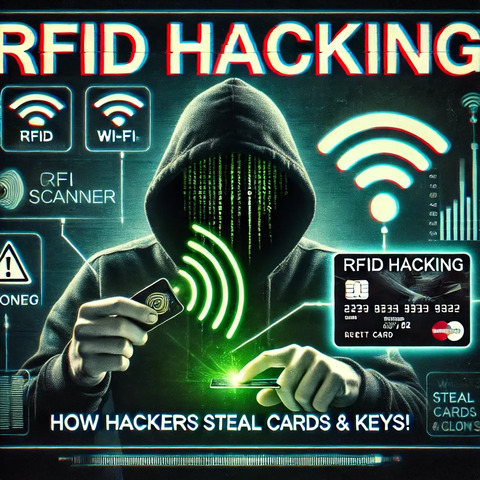RFID Hacking: Learn, Exploit & Defend Against Attacks

You have a magic key to your house, your school, and even the candy shop. But it's not an ordinary key; it is invisible and works just because it's close to the door. That's RFID—a magic key that opens things, pays for things, and counts things using invisible waves.
Now, what if someone bad could steal your magic key secretly? That's RFID hacking! In this blog, I will tell you all about it in really simple words with examples so that even a five-year-old (or a cybersecurity newbie) can get it.
What is RFID?
RFID is an abbreviation for Radio Frequency Identification. It's a technology that allows objects to communicate with each other through invisible radio waves.
Let me imagine:
- A shop marks up toys with RFID so that it can keep track of how many are remaining.
- A school issues students RFID cards to enter the school.
- A metro card allows you to tap and go on the train.
- A credit card allows you to pay by tapping rather than swiping a chip.
These all employ RFID to send a hidden code that says to the system, "Hi, it's me! Open the door!" or "Charge my card for this transaction."
How Does RFID Work?
There are two key components in an RFID system:
- RFID Tag (The Magic Key)
- A tiny chip with an antenna containing a secret code.
- It may be embedded in a card, sticker, or even in animals for tracking.
- RFID Reader (The Magic Door)
- It transmits radio waves.
- If there is a tag around, it echoes back its code.
You are at a playground with a walkie-talkie. You call out,
"Hey, who's there?"
Your friend answers, "It's me, Bob!"
That's essentially how RFID operates—except the RFID tag exclaims, "It's me, ID#1234!"
How Hackers Steal Magic Keys (RFID Hacking)
Now, suppose someone eavesdrops on your walkie-talkie chat and discovers that Bob always answers with "It's me, ID#1234!"?
A crafty hacker can now impersonate Bob by repeating the same. That's how RFID hacking occurs!
These are the most frequent methods by which malicious actors steal RFID codes:
Eavesdropping (Secret Listening)
A hacker can utilize a special gadget to "listen" when you tap your metro card or make a contactless transaction.
Example:
Suppose you're speaking on a walkie-talkie with your friend. But someone around you is listening secretly and noting down what you are saying.
- You tap your metro card.
- The RFID reader says, "Who's there?"
- Your card responds, "It's me, ID#5678!"
- A nearby hacker overhears and jots down your ID.
- Later, they duplicate your ID on a counterfeit card and use it!
Cloning (Creating a Duplicate)
After a hacker obtains your RFID code, they can make a counterfeit card with the same ID.
Example:
Suppose you possess a library card. A friend copies down the number of the barcode on the reverse side. Subsequently, they print out a fresh card bearing the same barcode and use it as if it belongs to them!
Replay Attacks (Redirection of a Stolen Code)
Suppose someone captures your voice and replays it afterwards?
That's what occurs in a replay attack. A hacker captures the RFID signal when you swipe your card, then plays it back later to unlock the door without your card.
Example:
A hacker is outside a hotel door and captures someone swiping their room key.
Later, they play back the capture, and the door opens again!
Brute Force (Guessing the Code)
Certain RFID systems employ simple number codes such as 0001, 0002, 0003. A hacker may guess codes until one that works is discovered.
Example:
Consider a lock with only four buttons (1, 2, 3, 4). If you attempt all the combinations, you'll find the one that opens it eventually!
Denial of Service (Jamming the Signal)
Hackers block RFID signals by sending too much noise, similar to playing loud music on a walkie-talkie so nobody can hear.
Example:
Your teacher is calling your name in a loud classroom, but everybody yells at the same time. You don't hear your name, so you don't answer. That's a Denial of Service (DoS) attack—blocking RFID communication.
Real-Life RFID Hacking Stories
- Hacking Office Keycards: A thief with an RFID scanner passes close to an employee at a coffee shop. Their reader picks up the employee's office keycard from their pocket. The thief copies the card later and enters the office as if an employee!
- Hacking Contactless Payments: A shoplifter carrying an RFID reader lurks near individuals in a mall. When another has a contactless bank card, the thief lifts payment information and makes payments on the Internet.
- Hacking Car Key Fobs: RFID key fobs unlock many current automobiles. Hackers use signal amplifiers to trick automobiles into believing that the key is nearby and therefore lock and start the car.
How to Remain Protected against RFID Hacking
Now that you understand how to hack RFID, here's how to keep yourself safe:
- Use RFID-Blocking Wallets: Such wallets contain radio wave-blocking material, and hence, hackers can't read your credit cards.
- Keep an Eye Out: If the person standing close to you at a store seems suspicious, then they could be attempting to read your card.
- Turn Off Contactless Payments: In case you never use RFID payments, turn off contactless payments in your bank app.
- Employ Two-Factor Authentication: If your office keycard requires a PIN code or fingerprint, it's considerably more difficult to break into.
- Move to Secure RFID Systems: Older RFID systems rely on insecure encryption (such as MIFARE Classic). Newer systems such as MIFARE DESFire are more secure.
- Place RFID Cards in a Metal Case: Metal suppresses RFID signals. A basic aluminum case will prevent hackers from reading your card.
Conclusion
RFID is a super useful technology, but it can be hacked if not secured properly. Hackers can listen in, copy cards, replay signals, or jam RFID systems.
To stay safe:
- Use RFID-blocking wallets
- Enable PIN codes
- Upgrade old RFID systems.




